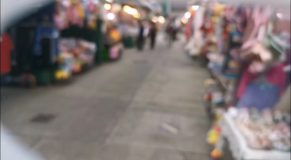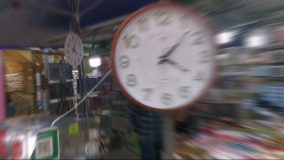Video Essay:
Disappearing city: Hawker Stalls, Bowring Street, Jordan
Introduction
As the birthplace of many well-known film and television productions, Hong Kong’s distinctive urban culture and architecture have always been the object of hot discussion. Among all the important factors, one of my favorites is those Hawker Stalls along the street that appear in many Hong Kong movies. With the change in consumers’ habits and the stricter rules, nowadays many street vendors are disappearing, however, I believe that Hawker Stalls have their values and should be persevered.
The following essay will explain my video setting at Bowring Street, a street in Hong Kong in Jordan, describing the theme and the method of conducting the video. Also, there will be discussions on the value of Hong Kong Hawker stalls in movies, why they are disappearing, how they help reveal the characteristics of the city, and what we could do to preserve them.
Methodology
I mainly use Literature research and Field trip in my study. For the first part, I view the works of previous scholars about Hong Kong films to get ideas for my video and discuss the importance of Hawker Stalls and how they could work in films. Then, I take Bowring Street as a case to do a field visit and produce my video.
For the process of doing research, I referred to a similar study carried out by Lau, Leung, and Yuen, they defined Hawker Stalls as “Old Hong Kong Features” and took Temple Street as an example to argue that these features “have been disappearing in this rapid changing city” (Lau, K. W., Leung, M. C., & Yuen, Y. L, 2014).
Literature Review
Hawker stalls have always been an integral part of Hong Kong’s street culture (Tsui, 2016), and it’s one of the most crucial elements in Hong Kong movies (Lai, C. H., & Choi, W. Y., 2013). For instance, in director Wong Kar-wai’s film The Mood to Love (2000), the meeting of the two characters at a hawker stall serves as the backdrop for their love, “highlighting the role of these spaces as social hubs” (Cheung, 2012). Furthermore, Hawker Stalls in films are often a shot of Hong Kong society, “reflecting the multicultural, social dynamics and economic differences of Hong Kong” (Yau, 2014). For example, in the film Chungking Express (1994), also directed by Wong Kar-wai, the protagonist frequents a hawker stall, “showing how much these venues mean to people from all walks of life” (Mathews, 2008).
But why is this lively place disappearing? South China Morning Post predicts that “Hong Kong’s hawkers will die out in less than 50 years if current stringent policies don’t change”, they mentioned that the number of hawkers decreased a lot since new rules against illegal stalls were established, and the number of hawking license was limited. One of the opinions is that most license holders are becoming old while there are no new licenses issued for the youth, so, likely, hawkers will finally disappear.
Filming the Street
It’s a normal afternoon, the main character, a local Hong Kong boy called Leung, bought a package of cake from the store as usual and walked across Bowring Street on his way home. The story unfolds from the boy’s point of view, or more accurately, from the plastic bag in his hand. The idea for this design comes from the film “Walker” (Tsai, M. L., 2012), the character in the story carrying plastic bags in both hands, moving very slowly through some Hong Kong landmarks while everything around is going by fast, so it looks like the character and the city are not in the same system of time. Combining with the view from “Walking in the City”, where “walking” by ordinary citizens is described as “an elementary form of this experience of the city” (De Certeau, 1984), I decided to use a special sight and a “walking” character to make audiences feel like they are doing “space practice” with the boy in the video, and therefore be more involved.


Turning to the scene of Hawker Stalls, we can see that many people wandered through the street, but few stopped at the stalls. Even if someone does, it’s only for a minute or two, look around and walk away without buying anything, and this reflects the reality that Hawker stalls are facing a declining consumer demand.


The first kind of stalls that appear in the video are about children’s clothes and toys, while the last are clothes for the elderly. This is aimed to express that the group of hawkers selling things that could cover people of all ages here, and the types of clothes from the young to elderly also used as a metaphor for the place where many people grow up, from children to adults, and hawker stalls are part of their memories for life.


Evaluation & Recommendation
Although I continue to say that Hawker Stalls are disappearing, there are some possibilities that they could be persevered. For Bowring Street, most of its consumers tend to be local citizens, so it is more likely to disappear when consumer demand decreases. But for streets that focus on attracting tourists, like Women Street, the stalls might always be there as a special scenic spot of Hong Kong.
Also, there used to be some government policies that supported these stalls, like Hong Kong’s 4,000 hawkers received money from a subsidy scheme in 2012s, aimed at improving fire safety (Emily, T., 2012), which looks like that government still paid some attention to these Hawkers. I believe more Hawkers might stay if there are subsidies for them to lower the cost and improve their profitability of running the stalls.
Conclusion
Overall, in films, Hawker stalls with Hong Kong characteristics form a very life-like scene, play a crucial role in displaying the life of ordinary people and telling the story of small potatoes, and often serve as a microcosm of Hong Kong society and culture. In terms of preservation, the interests of visitors and subsidies from the government might help.
Bibliography
Lau, K. W., Leung, M. C., & Yuen, Y. L. (2014). Old Hong Kong at risk? Past, present and future of Temple Street . City University of Hong Kong, CityU Institutional Repository. http://dspace.cityu.edu.hk/handle/2031/7476
Lai, C. H., & Choi, W. Y. (2013). World Film Locations: Hong Kong. Intellect Books.
Ming-liang Tsai, (2012), Walker. https://vimeo.com/176551173
De Certeau, M. (1984). Walking in the City, and Spatial Stories. In S. Randall ed., The Practice of Everyday Life (pp. 91-110, 115-130). University of California Press.
Jennifer, N. (2023). Closing time: How Hong Kong’s hawkers face a struggle to survive. South China Morning Post.https://multimedia.scmp.com/hawkers/
Emily, T. (2012). Hawkers to be offered cash to make stalls more fire-resistant. South China Morning Post. https://www.scmp.com/?utm_source=copy-link&utm_campaign=1028909&utm_medium=share_widget
Cheung, E. (2012). Hong Kong Screenscapes: From the New Wave to the Digital Frontier. Hong Kong University Press.
Mathews, G. (2008). Globalization and the Hawker Stall Culture in Hong Kong. In M. Olofsson (Ed.), Media in Motion: Cultural Complexity and Migration in the Nordic Region (pp. 57-68). Ashgate Publishing.
Tsui, C. (2016). Dai Pai Dong: Hong Kong’s Authentic Outdoor Dining Experience. South China Morning Post.
Yau, E. (2014). Hong Kong’s Street Culture: Representations in Films and Popular Media. In E. K. Tan (Ed.), Cities in Film: Architecture, Urban Space and the Moving Image (pp. 19-34). Intellect Books.
Liu Zihan 3036263373 liu2004@connect.hku.hk
You have done a great job on researching about the Hawker stalls! Also the opening of the flim is fantastic and creative at all. One thing that can be improved is the lens stabilization. The camera often shakes during filming that may affect perception. But overall it is a great work!
I found your video particularly captivating as it offered a Cantonese perspective and provided an intimate glimpse into the narrator’s personal life. The scenes you captured showcased a diverse array of booths and products, which I found fascinating. It also evoked a sense of concern for the potential disappearance of this place in the future. For improvements, consider incorporating contents from interviews with the narrator and/or local individuals whose lives are intertwined with this location. By seeking their personal feelings and experiences regarding the potential loss of this daily interaction, you can provide a more comprehensive and well-rounded perspective. Great work so far!
A good job! The way you present the content is interesting and creative. It is a novel way to show the old market and exchange feelings through the perspective of a local boy. The background music also fits the theme of disappearing city, which strengthens the feelings of regret. In terms of lens language, scene transitions are also smooth. And the way to capture the pedestrian through the reflection is very clever. Overall, it’s a good work related to disappearing city.
Zhao Yuxuan 3036127050